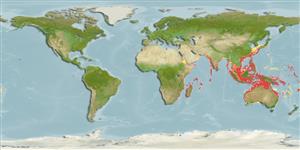Common names from other countries
Environment: milieu / climate zone / depth range / distribution range
экология
ассоциированный с рифами; пределы глубины 10 - 100 m (Ref. 349). Tropical
Indo-West Pacific: including the Persian Gulf, to Melanesia; north to Japan and south to Queensland.
Length at first maturity / Size / Вес / Возраст
Maturity: Lm ? range ? - ? cm Max length : 9.5 cm SHL самец/пол неопределен; (Ref. 349); common length : 6.0 cm SHL самец/пол неопределен; (Ref. 349)
Locally consumed by fishermen and used for shellcraft. Commonly trawled offshore in the tropical West Pacific (Ref. 349). Found offshore (Ref. 799). In general, members of the family Personidae are carnivores (Ref. 67623). A specialist feeder on chaetopterid polychaetes (Ref. 128693).
Life cycle and mating behavior
половая зрелость | размножение | нерест | икра | Fecundity | личинки
Members of the order Neotaenioglossa are mostly gonochoric and broadcast spawners. Life cycle: Embryos develop into planktonic trocophore larvae and later into juvenile veligers before becoming fully grown adults.
Основная ссылка
ссылки | координатор | соавторы
Poutiers, J.M. 1998. (Ref. 349)
Статус Красного Списка МСОП (Ref. 130435)
Статус СИТЕС (Ref. 108899)
Not Evaluated
Not Evaluated
Угроза для людей
Harmless
Использование человеком
| FishSource |
инструменты
дополнительная информация
Возраст/РазмерыростЗависимость между длиной и массой телаЗависимость между длинамиморфологияличинкичисленность
ресурсы в Интернет
Estimates based on models
Preferred temperature
(Ref.
115969): 24.3 - 29, mean 28 (based on 1344 cells).
Уязвимость
Low vulnerability (10 of 100).
Категория цены
Unknown.
